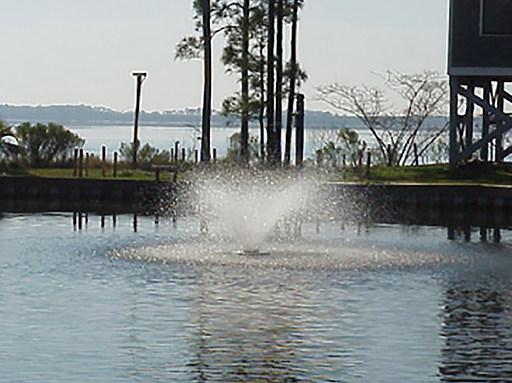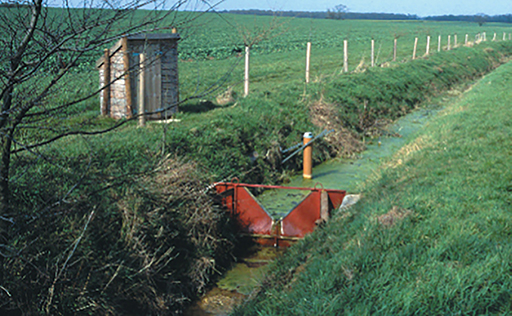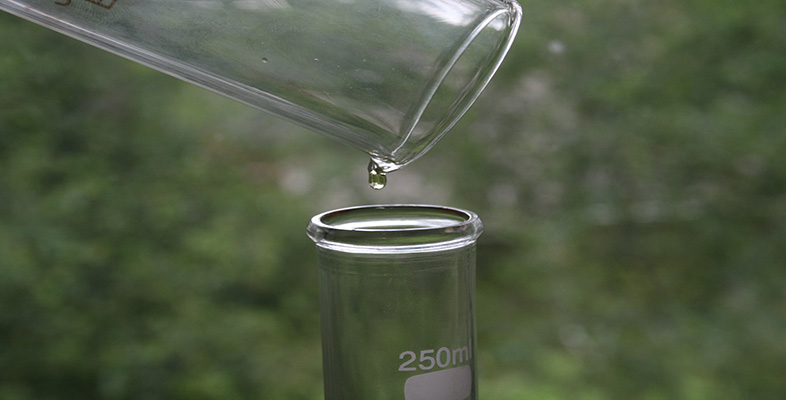4.1 Water treatment processes
The quality of public water supplies can be improved by water treatment, and this may be necessary before water from a particular source can be used. The most common treatment processes, in sequence, are:
Screening: Debris such as leaves and plant fragments are removed by passing the water through a series of coarse metal screens.
Settling and oxidising: The water is then stored in a reservoir (or settling pond), so that sediments and some of the organic particles that escaped the straining process settle on the bottom, and the bacteria (which are all too small to be removed by straining) gradually die. Storage has the disadvantages that the reservoirs required use a lot of land, and algae may grow in the water because of a build-up of nitrates. Other organic impurities, which can give a taste or odour to the water, are oxidised in the upper layers of the reservoir. Water sprays, rather like fountains, are often used to aerate the water (Figure 16) so that the concentration of dissolved oxygen in the water is increased. Thus organic impurities can be oxidised to harmless substances, and some dissolved metal ions are oxidised to give insoluble compounds that can then be filtered out of the water.
Flocculation: Even after straining and storage, raw water may contain considerable quantities of suspended matter. Most of this consists of colloidal matter (which is matter about 10-8 m in diameter in a form between solution and particulate form, and having negative electric charges).

The colloidal matter can be reduced by filtration; but if there is a considerable quantity, it is usually more economic to make it flocculate. (The colloidal particles are neutralised by adding a chemical to the water that has the opposite charge to the colloidal particles. The particles then coalesce into bigger particles and sink out of the water.)
Filtration: Filtration through sand and gravel then removes any fine particles of suspended matter and small organisms (mostly less than about 6 × 10-5 m in diameter) that still remain. In addition, algae and bacteria develop on and below the surface of the sand, where they decompose organic matter in the water passing through and digest some of the nitrates, phosphates and carbon dioxide dissolved in it, thus further purifying the water.
pH correction: The EU guideline for the pH of drinking water is 6.5-9.5 (Table 4a); this range was chosen because more acidic water might dissolve metal pipes in the distribution system and more alkaline water might leave salt deposits in the pipes. In the UK it is often necessary to add an alkali such as lime to water with a low pH, especially the water from peaty upland areas.
Disinfection: The final treated water should contain no pathogenic bacteria, so the water must be disinfected. In the UK the most common method of disinfection is the use of chlorine (occasionally you may notice a slight smell of chlorine in your tap water). It is a method that has been used extensively for over 70 years. Water companies have to ensure that enough chlorine remains in the water after it leaves the treatment works to help keep the water safe on its journey to the tap. Other forms of disinfection include ozone and ultraviolet light, but these do not remain in the water during distribution, so in both cases a small amount of chlorine is added before the water goes into the distribution system. Disinfection is not very effective against parasites such as Cryptosporidium and Giardia (which can cause illnesses with severe diarrhoea lasting a number of weeks). If there is a risk of these being present they must be removed during the filtration stage of treatment.
Some waters require more specialised treatments which are expensive, such as:
Ion exchange: This process is used to remove nitrate from groundwater (Box 5), and in some cases to soften water. Ion exchange is very similar to the process used in domestic water softeners, where water is passed through a bed of special resin particles.
Activated carbon: Activated carbon, often in association with ozone, is used to remove organic substances. Some of these substances occur naturally and others are contaminants, such as pesticides, that occur because of human activities. The ozone breaks down the organic substances, which are then adsorbed on the surface of the carbon.
Softening: Excessive hardness of water is usually reduced ('softened') by precipitation or by the exchange of ions brought about by adding appropriate chemicals.
Most developing countries, however, not only cannot afford to disinfect their water, but outside the main towns often have no piped water to disinfect. Every year, millions of people, particularly children, die of diarrhoea infections carried by contaminated water.
Box 5 Nitrate in drinking water
Intensive farming has caused the nitrate concentration in surface water and groundwater in some areas to increase. In parts of the UK it is now above the EU guide value of 50 mg l-1 (Table 4a).
There is concern that human health may be affected if these high-nitrate waters are used for drinking water. The nitrate comes from:
High levels of fertilizer used in intensive farming to obtain high cereal yields. Some of the nitrogen in the fertilizer may not be taken up by the crop, and then may be leached from the soil, or infiltrate into groundwater.
Spreading large quantities of manure or slurry on farmland from intensive stock-rearing.
Effluent discharges from some sewage works, and the use of sewage sludge on farmland (Section 5).
The first two bullet points mean that all major intensively farmed areas are affected, particularly the cereal-growing areas of northern Europe and the USA, and the stock-rearing parts of northern Europe (Brittany, the Netherlands and Denmark).
To reduce nitrate concentrations by water treatment methods requires ion exchange or biological denitrification. Both are very expensive procedures. Other 'lateral' approaches are being used instead:
Finding alternative sources of water—closing some boreholes and opening new, low-nitrate ones.
Blending (diluting) high-nitrate water with that from a low-nitrate source.
Reducing the inputs of nitrate into water, by using government legislation to reduce the use of fertilizers, manure and slurry in designated areas, called Nitrate Vulnerable Zones in the EU. In these zones there are compulsory restrictions to reduce nitrate leaching from the soil, encouraging farmers to change their farming operations to less intensive ones, such as switching from cereals to grassland or using buffer strips (Figure 17).

Groundwater seldom requires much treatment, mainly because aquifers are efficient natural filters; disinfection is usually enough. Surface water, however, presents more problems. Unpolluted river water may require straining, storage, aeration, filtration and disinfection. If the source of raw water is a poorer quality river, these treatments may have to be repeated several times. Amsterdam, for example, has the misfortune to be at the downstream end of the Rhine. To make the poor quality Rhine water palatable it is successively aerated, filtered, aerated, disinfected, aerated, filtered, stored, aerated, filtered, aerated and disinfected again. Although it may be safe to drink after all this treatment, it still occasionally tastes awful!
The Amsterdam water is river water that has been used many times on its way to the sea, as is the water from the Thames used by London. The quality of such recycled water depends on the efficiency of the sewage treatment, and in the next section we look at the processes involved.
Activity 6
Table 5 gives the chemical compositions of a natural water. Would the water in Table 5 be a suitable source of water for (1) an EU public water supply, or (2) irrigation?
| Concentration/mg l-1 | |
| bicarbonate | 50 |
| Calcium | 5 |
| Chloride | 4 |
| Iron | 0.1 |
| Magnesium | 1 |
| Potassium | 4 |
| Silica | 135 |
| Sodium | 28 |
| Sulphate | 8 |
| TDS | 242 |
| p H | 7.6 |
Answer
a.The EU standards in Table 4a suggest that the water is suitable for a public water supply as far as indicated for the substances listed in Table 4a (but this is not the full list). However, the water may have to be treated to reduce any organic pollutants (not given in Table 5).
b.The water is unsuitable for irrigation as the sodium concentration is much greater than the combined calcium and magnesium concentrations.
